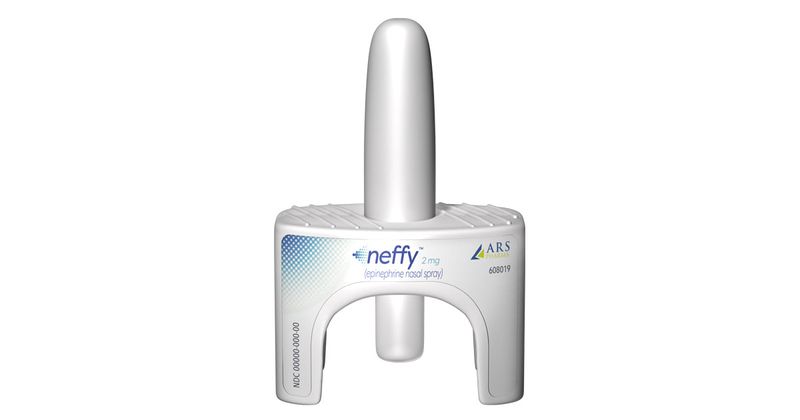Q&A: Epinephrine nasal spray offers advantages for caregivers, patients
In a recent study by Tanimoto and colleagues, neffy produced pharmacodynamic results that were comparable with or higher than autoinjectors and manual injection, including more efficient increases in blood pressure.
Healio spoke with Erin Malawer, cofounder of the Food Allergy Collaborative and executive director of AllergyStrong, to find out more about the potential advantages and disadvantages of epinephrine nasal sprays.

Healio: Are there any benefits or disadvantages to alternatives to injectors for epinephrine administration?

Malawer: Although epinephrine is the only medication that can stop a severe allergic reaction, many people are hesitant to use it when needed. Patients and caregivers are fearful of both giving and receiving the injection required to deliver the epinephrine, and studies show that delays in administration can result in negative outcomes.
Fear of the needles in epinephrine autoinjectors (EAIs) is not without warrant. Although EAI design has improved over time, lacerations and injury have occurred. Both patients and caregivers often worry they will administer the dose incorrectly.
Intranasal administration is a breakthrough for food, drug and venom allergic communities. Delivering epinephrine through nasal spray is far less invasive, making it more accessible to those who need it. Reducing worry and hesitation about epinephrine at the onset of an allergic reaction will encourage patients and caregivers to use it when it is needed most. This will save lives.
However, intranasal administration may be difficult or impractical for very young patients in an emergency. We will be watching the continued development of this product to understand at what age children can safely self-carry and self-administer intranasal epinephrine.
Healio: How do these findings compare to your own experience?
Malawer: I would have stopped my own son’s anaphylaxis sooner had intranasal epinephrine been available at that time. The first time my son experienced anaphylaxis, I had the same hesitation many caregivers do.
Among the million thoughts rushing through my head as his condition became more dire by the second was concern about administering epinephrine properly, as well as his psychological well-being. If I gave him a shot unnecessarily, would he be afraid of using an autoinjector again in the future when it was needed? I did not want to harm him physically or emotionally or compromise his future use of this lifesaving device.
And I was not the only one hesitant in this moment. I had two doctors by my side, both of whom hesitated to give our EAI, preferring less-invasive methods to treat him initially.
Patients and caregivers across the socioeconomic and allergic spectrum expressed a desire for an alternative to injectable epinephrine during the Externally-Led Patient-Focused Drug Development for Food Allergy meeting led by the Food Allergy Collaborative in September 2021. Stories of needle injury, discomfort and hesitation were a common theme in the testimonies and audience participation given to the FDA.
Healio: Are there any takeaways for clinicians in the study by Tanimoto and colleagues?
Malawer: Understand the pharmacokinetic and pharmacodynamic differences between EAIs. Consider this information alongside lifestyle and financial considerations when recommending and prescribing EAIs to your patients. Age of patient, comfort with EAIs, ability to self-administer as well as lifestyle should play a role in recommending one method or brand of epinephrine delivery over another.
For example, to caregivers of very young children, a provider might recommend a traditional EAI. But a teenager in high school may be more likely to use the intranasal spray.
Cost also is a significant issue. Currently, autoinjectors cost between $300 and $500 a set, and insurance coverage of different brands varies.
Size of the EAIs also matters. Male patients and caregivers have a more difficult time carrying autoinjectors, as many do not fit in their pockets, and they are less likely to always carry a bag with them.
Healio: What should the next step be in this research?
Malawer: I would love to see a real-world study of the time between recognition of symptoms to epinephrine use comparing traditional EAIs, manual injection and intranasal spray, but that may be impossible.
However, an additional study to evaluate willingness/ease of use as well as efficacy would validate intranasal administration in the eyes of providers and patients. Knowing that early administration of epinephrine leads to more favorable outcomes in cases of severe allergic reactions, a study of ED cases involving intranasal epinephrine might be interesting. For instance, such a study could evaluate the percentage of ED patients who needed further treatment comparing those who used intranasal spray with those who use intramuscular administration.
I also would love to see a study of the heart function of ED patients presenting with anaphylaxis after using intranasal epinephrine as compared with those using EAIs.
Healio: Do you have any further comments on nasal spray as an alternative delivery system?
Malawer: Intranasal administration of epinephrine is so promising. It is a dramatic development that patients have longed for, and its availability cannot come soon enough!
References:
- ARS Pharmaceuticals announces FDA acceptance of NDA for neffy (epinephrine nasal spray) for the treatment of allergic reactions (type I) including anaphylaxis. https://ars-pharma.com/2022/10/21/ars-pharmaceuticals-announces-fda-acceptance-of-nda-for-neffy-epinephrine-nasal-spray-for-the-treatment-of-allergic-reactions-type-i-including-anaphylaxis/. Published Oct. 21, 2022. Accessed Jan. 13, 2022.
- Tanimoto S, et al. Ann Allergy Asthma Immunol. 2022;doi:10.1016/j.anai.2022.10.024.
For more information:
Erin Malawer can be reached at erin@allergystrong.com.
